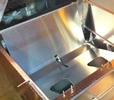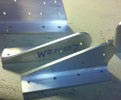


random user submitted photo
Turbo time?
27 posts
• Page 3 of 3 • 1, 2, 3
Re: Turbo time?
A fuel burn of 8 GPH suggests 120 HP. This is a rough calculation using 8 GPH as a 172 number at 70% power. If it was my turbo aerovee I would be excited for 120 HP for the first 1000', and 80 HP/4GPH at altitude. For Reno I would add nitrous and spray cooling bars.
Bryan Cotton
Poplar Grove, IL C77
Waiex 191 N191YX
Taildragger, Aerovee, acro ailerons
dual sticks with sport trainer controls
Prebuilt spars and machined angle kit
Year 2 flying and approaching 200 hours December 23
Poplar Grove, IL C77
Waiex 191 N191YX
Taildragger, Aerovee, acro ailerons
dual sticks with sport trainer controls
Prebuilt spars and machined angle kit
Year 2 flying and approaching 200 hours December 23
-

Bryan Cotton - Posts: 5489
- Joined: Mon Jul 01, 2013 9:54 pm
- Location: C77
Re: Turbo time?
BRIEFLY is right. He says 8GPH at 40 MAP. Sounds like a lot. I'm not sure a NA Aerovee can be made to burn over 5.5 GPH. I'd like to see some more detailed Turbo vs NA fuel burn comparisons.
Well, I'm not an expert on Turbos; but it would intuitively make sense that you'd want to bias the system towards running a bit rich at the high end of your MAP/RPM range, right? Not sure how the 8GPH figure will drop off at lower MAP/RPMs (and therefore lower boost levels).
--Noel
- NWade
- Posts: 527
- Joined: Mon Aug 08, 2011 3:58 pm
Re: Turbo time?
If we use an average fuel burn of 0.46 lbs/hp/hr, 8 gph works out to 104 hp. It will be interesting to see what the actual specific fuel consumption will be. I am also curious about the following:
- Service ceiling
- Altitude for best speed
- C of G effects
- Intake temperature rise
I am also wondering about a pitot-style fresh air intake with the fuel tank vented into the intake or on its own pitot-style vent. If the fuel pressure can be made to rise with the intake pressure, the AeroInjector should continue to operate normally. It might not be feasible to vent the fuel tank into the intake due to the challenge of preventing sloshing fuel from entering the intake. Lots to think about.
I ordered a turbo kit today.
Gunther
- Service ceiling
- Altitude for best speed
- C of G effects
- Intake temperature rise
I am also wondering about a pitot-style fresh air intake with the fuel tank vented into the intake or on its own pitot-style vent. If the fuel pressure can be made to rise with the intake pressure, the AeroInjector should continue to operate normally. It might not be feasible to vent the fuel tank into the intake due to the challenge of preventing sloshing fuel from entering the intake. Lots to think about.
I ordered a turbo kit today.
Gunther
Tri-gear Sonex, Turbo AeroVee, dual controls, 70% complete
- Gunther
- Posts: 51
- Joined: Sat Mar 22, 2014 5:23 pm
Re: Turbo time?
Gunther wrote: If the fuel pressure can be made to rise with the intake pressure, the AeroInjector should continue to operate normally. It might not be feasible to vent the fuel tank into the intake due to the challenge of preventing sloshing fuel from entering the intake. Lots to think about.
I think I understand where you are going with this, has it been done before in similar applications? Thoughts from a non-expert:
1) As presently configured, with a given needle and throttle setting, the AeroInjector fuel "drip" varies according to fuel pressure, and that pressure is determined by two things: air pressure in the tank and head pressure due to fuel weight. Plumbing the tank vent into the intake would increase one of these factors, but not the other one, so the total fuel pressure would not increase linearly with increasing MAP. Also, overall fuel flow through an orifice does not increase linearly with an increase in fuel pressure. Given this, we shouldn't expect the mixture to stay close to constant with increasing MAP--but it should move int he right direction and might be close enough.
2) The Aerovee turbo setup is a "pull through" design, meaning the carb is first and the fuel laden (explosive) mixture enters the TC compressor, then goes to the cylinders. If there's an ignition source, the mixture in the induction system will burn. If the fuel tank vent is open to that same induction system, well . . .it is something to consider. The fuel tank can be full of flammable vapors and I share the cockpit with it, so this is something I'd want to think through very carefully.
Congrats on your turbo kit order--report back!
Mark Waldron
Sonex 1230 (Builder: Jay Gibbs)
Aerovee, Trigear
Sonex 1230 (Builder: Jay Gibbs)
Aerovee, Trigear
- vigilant104
- Posts: 265
- Joined: Wed Nov 09, 2011 3:34 pm
- Location: Near Dayton, OH
Re: Turbo time?
It's interesting to see that others are picking up on the turbo idea. I have been running Sonex #0525 with a mecanical lifter Jab 22A and a turbo for some 4 years now. Contrary to the Sonex setup, mine is a press through system with a Bing 64 from a Rotax 914. Max boost is limited to 42"Hg. There are some pics from th installation on the Aus Rotec website (mostly due to the LCH conversion). The engine pulls the same Sensenich prop as the Jab 33A, giving WOT static 2800 rpm and WOT cruise 3500 rpm (too much!!), both at 42 in. I have had two major issues with the installation: the first, most likely well solved with the completely different AeroVee setup, is fuel distribution to the cylinders and the ensuing egt spread. The second is excessive cht's during ground running. You need to understand that a properly installed Sonex cowling cools very well- provided you have airspeed. But things may start to happen on a hot day after you are finished with start up, mag checks, taxi to hold and waiting in line for take off. Watch your temps like a hawk! I have not read the AeroVee turbo manual, so I don't know the temp limits, but believe me- cht and egt are coming on fast in a full power take off run and climbout. In my country summer temps are nothing near the desert like conditions you may experience in the US, even so a friend of my lost his (turbo) Rotax 914 the other day during take off (yes, this one has an intercooler as well), because the centre electrode in one of his NGK plugs came off. The plane had been standing with a hot engine in the blazing sun for hours, and it is suspected that the intercooler became an interheater. Also bear in mind that strictly speaking NGK does not approve their plugs for aviation use, see the piece of paper in each plug package.
Sonex A #0525- SG, DS.
EdgePerfomance EP915ECI, 123HP
EdgePerfomance EP915ECI, 123HP
- Kai
- Posts: 305
- Joined: Wed Jul 30, 2014 1:36 am
- Location: ICAO ENHS
Re: Turbo time?
Do we know the service ceiling for the AeroVee Turbo?
- thad14433
- Posts: 17
- Joined: Sat Aug 02, 2014 9:23 am
Re: Turbo time?
Im excited about that turbo kit hope it works I have a Rotax 912 uls for my build but If I hear good things about this turbo aerovee I may leave the rotax sit.
-

Lsaircraft - Posts: 25
- Joined: Wed Apr 23, 2014 1:01 pm
- Location: Maurice IA
27 posts
• Page 3 of 3 • 1, 2, 3
Who is online
Users browsing this forum: No registered users and 49 guests







